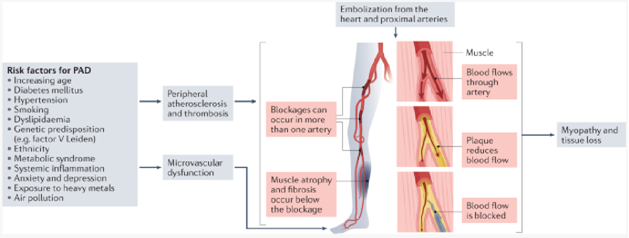The nurse has written a plan of care for a client diagnosed with peripheral arterial insufficiency. Which intervention is the most appropriate for this diagnosis?
Elevate the legs and arms above the heart when resting.
Encourage the client to engage in a moderate amount of exercise.
Encourage extended periods of sitting or standing.
Discourage walking in order to limit pain.
The Correct Answer is B
The most appropriate intervention for a client diagnosed with peripheral arterial insufficiency is: Encourage the client to engage in a moderate amount of exercise. Peripheral arterial insufficiency is a condition characterized by reduced blood flow to the extremities, typically the legs, due to narrowed or blocked arteries. Regular exercise is an important component of managing peripheral arterial insufficiency. Exercise helps improve circulation, promote collateral blood vessel development, and increase the distance a client can walk before experiencing pain (intermittent claudication). Therefore, encouraging the client to engage in a moderate amount of exercise, such as walking, under healthcare provider guidance is crucial.]

The other options are not appropriate interventions for peripheral arterial insufficiency:
Elevating the legs and arms above the heart when resting: While elevation can be beneficial for certain conditions, such as reducing swelling in venous insufficiency, it is not the primary intervention for peripheral arterial insufficiency. Elevation alone does not improve arterial blood flow and may not effectively address the underlying circulatory issues.
Encouraging extended periods of sitting or standing: Prolonged sitting or standing can further restrict blood flow and exacerbate symptoms in clients with peripheral arterial insufficiency. Encouraging regular movement and avoiding prolonged immobility is important to maintain adequate circulation.
Discouraging walking in order to limit pain: While walking may cause pain or discomfort in clients with peripheral arterial insufficiency (intermittent claudication), it is important to encourage walking as part of an exercise regimen. Walking helps improve symptoms over time and promotes overall cardiovascular health.
Nursing Test Bank
Naxlex Comprehensive Predictor Exams
Related Questions
Correct Answer is D
Explanation
Transesophageal echocardiography is a diagnostic procedure that involves inserting a probe into the esophagus to obtain detailed images of the heart. In some cases, an access line may be initiated in the femoral artery to monitor blood pressure during the procedure and administer medications if needed. Informing the client about this aspect of the procedure helps ensure that they are aware of what to expect and can provide informed consent.

Let's go through the other options and explain why they are not the most appropriate actions:
Instruct the client to drink 1 L of water before the test: This action is not necessary for transesophageal echocardiography. Drinking water before the test is typically done for certain abdominal or pelvic ultrasound examinations to provide better visualization. However, for TEE, the probe is inserted into the esophagus, and drinking water is not required.
Administer intravenous (IV) benzodiazepines and opioids: The administration of intravenous benzodiazepines and opioids is not a routine part of preparing a client for TEE. The need for sedation or analgesia during the procedure would be determined based on the individual client's condition and level of discomfort.
Inform the client that the client will remain on bed rest following the procedure: While some post-procedure instructions may be given to the client, such as avoiding eating or drinking until the effects of sedation wear off, informing the client that they will remain on bed rest following the procedure is not a specific requirement for TEE. Post-procedure instructions can vary depending on the individual client's condition and the healthcare provider's recommendations.
Correct Answer is C
Explanation
Maintaining a 2 gram-sodium (salt) diet is an important aspect of managing hypertension. High sodium intake can contribute to elevated blood pressure. Therefore, reducing sodium intake is recommended to help control blood pressure levels. The nurse should provide guidance on reading food labels, avoiding high-sodium processed foods, and incorporating a diet rich in fruits, vegetables, and whole grains.
The other options listed are not appropriate or beneficial for managing hypertension:
Maintaining a low-potassium diet: Potassium is an essential mineral that helps regulate blood pressure. While specific potassium restrictions may be necessary for some individuals with certain medical conditions, most people with hypertension do not need to limit their potassium intake. In fact, a balanced diet with adequate potassium is generally recommended.
Skipping a medication dose if dizziness occurs: It is not advisable to skip medication doses without consulting a healthcare provider. Hypertension medications are prescribed to help control blood pressure, and missing doses can lead to uncontrolled hypertension and potential complications. If the client experiences dizziness or other side effects from the medication, they should consult their healthcare provider for appropriate management.
Drinking three glasses of wine a day: Excessive alcohol consumption can contribute to elevated blood pressure. The recommended alcohol intake for individuals with hypertension is moderate or limited to moderate levels, which typically means no more than one drink per day for women and two drinks per day for men. Drinking excessive amounts of wine or any alcoholic beverage can negatively affect blood pressure control.
Whether you are a student looking to ace your exams or a practicing nurse seeking to enhance your expertise , our nursing education contents will empower you with the confidence and competence to make a difference in the lives of patients and become a respected leader in the healthcare field.
Visit Naxlex, invest in your future and unlock endless possibilities with our unparalleled nursing education contents today
Report Wrong Answer on the Current Question
Do you disagree with the answer? If yes, what is your expected answer? Explain.
Kindly be descriptive with the issue you are facing.
